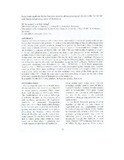Seed-bank analysis for herbaceous species along grazing gradients in the Sandveld and Hardveld grazing areas of Botswana
Date
2007Author
Nsinamwa, M.
Sebego, R.J.
Publisher
Botswana College of Agriculture, http://www.bca.bw/Research/bojaasBca/InstructionToAuthors.htmType
Published ArticleMetadata
Show full item recordAbstract
Grasses and forbs in Southern Africa have been understudied in terms of species richness and factor that affect diversity patterns. To gain a better understanding of factors affecting patterns of herbaceous plant species seedbank around water points, six boreholes ( three in each land zone) were randomly selected for sampling. Top soil layers of 20cm depth were sampled from six boreholes at distances of 50, 100, 200, 400, 800, 1500, and 3000m ( the Piosphere approach) in fenced and unfenced plots to determine the density and composition of the seedbank. The samples were allowed to germinate in the growth tray (10 x 15 x 8cm³) under controlled conditions (temperature, moisture) in a green house followed by daily counting of seedlings. Herbaceous plant species diversity was analyzed by using Simpson's diversity index. Analysis of varience on herbaceous species diversity was determined using the SAS software. Herbaceous plant community clustering was determined by using TWINSPAN, a FORTRAN programme. Significant (p=0.0001) germination variants were observed along the distance from livestock watering points. Most grass seedlings recorded germinated from soil samples obtained from from fenced plots, while less than 40% of the forb seedlings were. Most of the forbs species were recorded within 400m from the water points and that soils closer to water points also contained grass seeds despite the level of degradation and /or trampling.

